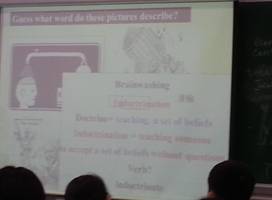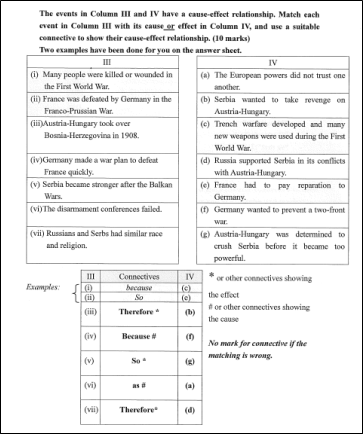Benefits of a coordinated approach
It has long been accepted that, when English is adopted as the medium of instruction in content subjects, subject teachers also need to accept responsibility for students’ language development. In its “Report on Review of Medium of Instruction for Secondary Schools and Secondary School Places Allocation”, the Education Bureau recommended that EMI schools “strengthen the learning of English through language across the curriculum by promoting collaboration between English Language teachers and content subject teachers, so that students can master the vocabulary, terms and expressions in each subject to support their learning in English.” Although this may seem obvious in theory, teachers may find it difficult to implement in practice; teachers may consider the work an additional burden, or they may LaCk expertise in the relevant areas. At Methodist College, in order to develop approaches which could be applied in a wide variety of subject areas, a group of teachers from the English, Mathematics, History, Geography and Integrated Science KLAs worked together in the LaC Committee to develop strategies and materials for the benefit of their colleagues. They worked together to establish a framework for mapping the curricula of the different subjects using text structures. English teachers took the lead in designing materials focusing on text structures and comprehension strategies which were used as models by teachers of other subjects. English teachers also worked on vocabulary learning strategies with students, and content subject teachers encouraged students to apply these skills in their own subject areas. This approach helped English and subject teachers to take up specific roles and also encouraged sharing across subjects. It also made teachers’ work more efficient, as English teachers were able to include elements such as affixation in their lessons which enabled students to cope better in content subject lessons. At regular meetings of the LaC Committee, teachers were able to discuss students’ language problems and develop common strategies for supporting their learning in English.
| Areas addressed by teachers in the LaC Committee |
| The materials developed addressed three main areas: |
| 1. |
Reading and writing in the content subjects, including text structures and comprehension strategies |
| 2. |
Vocabulary learning |
| 3. |
Aligning assessment with classroom teaching in terms of language |
| 1. |
Reading and writing in the content subjects, including text structures and comprehension strategies |
A number of strategies have been found to be beneficial in promoting academic literacy among students, both English Language learners and native speakers of English. Toregesen and colleagues (2007) identified the use of comprehension strategies and the teaching of text structures as helpful:
| |
- Comprehension strategies – Strategy instruction should be explicit and include modeling, guided practice, feedback and scaffolding. Student collaboration in comprehension strategies has also been shown to be helpful (Toregesen et al., 2007).
|
| |
- Text structure – Helping students organise the information through the use of graphic organizers and providing direct instruction on text structures and organizational patterns is helpful (Toregesen et al., 2007).
|
At Methodist College, English teachers took up the direct instruction, while subject teachers developed materials focusing on the same strategies and text structures. This meant that, when students encountered the strategies and text structures in their content subject lessons, they were already familiar with them from their English lessons. Subject teachers therefore did not need to repeat the detailed direct teaching.
According to Harmon and Wood (2008), a number of studies have found that metacognition is important in vocabulary learning. This includes the ability to work out the meaning of unfamiliar words from the context, should the text allow this, and also the understanding of word formation (prefixes, suffixes, roots etc.) At Methodist College, English teachers taught students the concept of word formation and provided numerous examples. Subject teachers identified common prefixes and roots in their own subject areas, and drew students’ attention to these during lessons when new words were introduced.

|
|

|
| A Science teacher draws students’ attention to the suffix “-or” in a lesson on the senses. |
|
A History teacher shows students how the word “indoctrinate” is formed. |
Science teachers also provided support for S1 students’ vocabulary learning by recording a vocabulary list for each unit and uploading it to the school’s server for students to use as a study aid.
| 3. |
Aligning assessment with classroom teaching in terms of language |
|
 |
The issue of students’ performance in examinations is often problematic when they are studying and taking examinations in a second language. Short (1993) says “The difficulty with assessment centres on isolating the language features from the content objectives so one does not adversely influence the other.” In other words, students need to be able to demonstrate their learning of the content subject without language issues getting in the way. At Methodist College, teachers in the LaC Committee worked together to devise a set of guidelines for teachers in preparing and setting examinations, in order to give students a better chance to show what they had learned. However, some language structures and vocabulary items had been taught in lessons,
 |
| and these were also tested in the relevant examination papers. In some cases, teachers were able to devise ways to combine the testing of language and content, as in the example on the right. |
|

